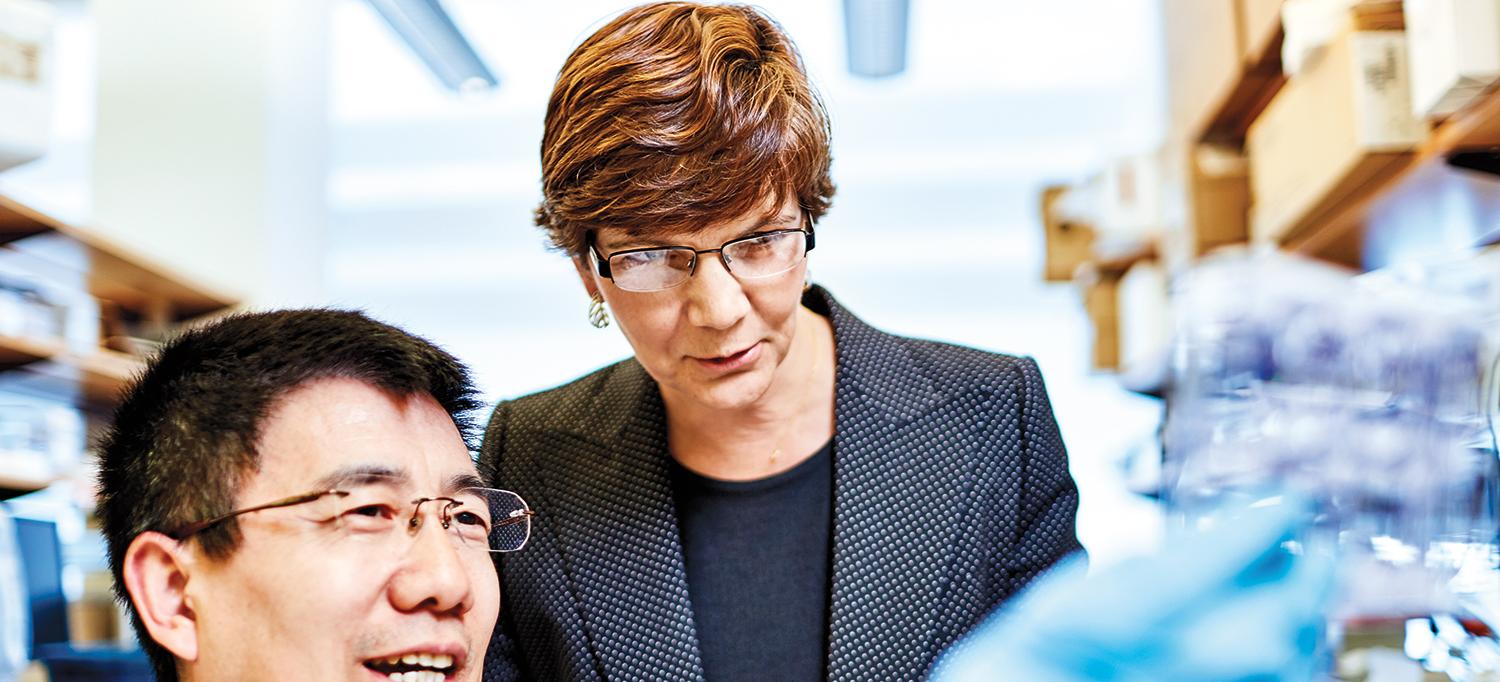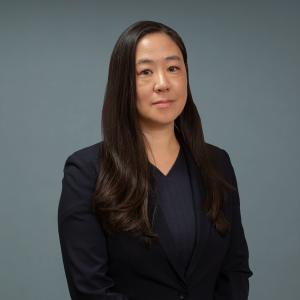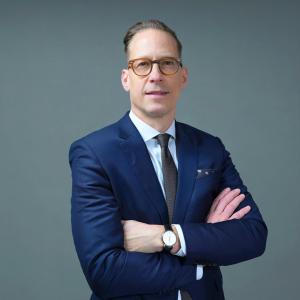
Diane Simeone, MD, consults with Lidong Wang, PhD, a researcher in her lab. Dr. Wang studies the mechanisms that drive metastasis in pancreatic cancer.
Photo: Jonathan Kozowyk
Diane M. Simeone, MD, an internationally recognized surgeon and scientist, joined NYU Langone last March as associate director for translational research at Perlmutter Cancer Center and head of its newly established Pancreatic Cancer Center. Previously, Dr. Simeone served as director of the gastrointestinal oncology program at the University of Michigan Comprehensive Cancer Center. There, she led the team that discovered pancreatic cancer stem cells, a subpopulation of cells within tumors that are especially resistant to treatment. We recently caught up with Dr. Simeone to discuss her mission to improve the odds for the more than 50,000 patients in the U.S. diagnosed with pancreatic cancer every year.
What sparked your interest in pancreatic cancer research?
When I was a surgical resident, I was amazed to learn how few people were doing research on pancreatic cancer. It became clear to me that to tackle a tough disease like this, it wasn’t enough to be a surgeon—I also had to pursue laboratory research. Having a close-up view of the cancer makes it very personal.
Despite recent advances in the treatment of cancer overall, pancreatic cancer still has a single-digit average survival rate. What makes it different from other cancers?
The disease rarely causes symptoms until it’s quite advanced, so most people have widespread disease at the time they’re diagnosed. Only about one in five have a tumor that can be surgically removed.
Even among that subset, pancreatic cancer rebounds 75 percent of the time, and the 5-year survival rate is still only about 25 percent. Why is even the best-case scenario so dire?
Clearly, there is something unique about the biology of pancreatic cancer that makes it deadly right from the start. Understanding why is core to our research mission.
Encouragingly, we already have a few significant clues. Not only do pancreatic cancer cells grow unusually fast, but they can also break off from the tumor early in the disease and spread. We know that scar tissue tends to form around the tumor, which may serve as a barrier to therapeutic agents.
And there’s a complex interplay between the tumor and its environment which further protects the tumor from chemotherapy and radiation and helps it evade the immune system.
Where do you see the biggest opportunities for making advances to address this disease?
First, our center is establishing a first-of-its-kind program for early detection and prevention. This includes a research initiative to identify biomarkers of abnormal pancreatic cells so we can intervene before they become invasive cancer cells. We’re also focusing on people who have had multiple family members with pancreatic cancer or who have mutations linked to pancreatic cancer. The goal is to develop new treatment paradigms to markedly delay or prevent the formation of pancreatic cancer in high-risk individuals.
“There’s traditionally been a nihilism surrounding pancreatic cancer because it is so deadly. People are often afraid to discuss their diagnosis. They don’t want to tell others what kind of cancer they have. We really need to change that.”—Dr. Diane M. Simeone
What are you doing to develop more effective treatments?
For one, we are studying pancreatic cancer stem cells, which are known to drive tumor initiation and metastasis, and are particularly resistant to treatment with chemotherapy and radiation. We believe targeting this subpopulation of cells is essential to a cure.
We also recognize that there is a large gap between scientific discoveries made in the lab and effective treatments for patients. Up until now, there hasn’t been a lot of incentive for pharmaceutical companies to develop drugs for pancreatic cancer patients because it has been viewed as an uncommon cancer. But with data predicting it will become the second-leading cause of cancer death by 2020, there is an unprecedented interest in finding new treatments.
We’re currently partnering with the pharmaceutical industry on a series of clinical trials, with funding from the Pancreatic Cancer Action Network, through a new clinical trial consortium called Precision Promise, which aims to translate the best laboratory science into novel treatments. Our goal is to create a wider pipeline of experimental treatments so that patients get personalized therapies that are much more likely to be effective.
You’re involved with several patient advocacy groups, and you work to promote awareness about pancreatic cancer. Why is outreach so vital?
When I speak to a large group and I ask how many in the audience have had a close friend or family member affected by pancreatic cancer, about one-third to one-half raise their hands, which everyone usually finds surprising. It is important that people know that pancreatic cancer is increasing in incidence and remains a disease with single-digit survival.
There’s traditionally been a nihilism surrounding pancreatic cancer because it is so deadly. People are often afraid to discuss their diagnosis. They don’t want to tell others what kind of cancer they have. We really need to change that.
I’ve spoken to members of Congress and many other groups to raise awareness. I want everyone to know about this disease and its challenges, and also to know that, thanks to recent advances, we now have real opportunities to make progress. I want to empower patients to talk about it. The more people know, the easier it will be o increase funding for research.
How do you cope emotionally with the fact that most of your patients with pancreatic cancer will die from the disease?
Caring for people who are dying gives me a sense of urgency—it is what drives me every day. When I run my laboratory meetings, I try to relay that sense of urgency to everyone on my team. Our research is about so much more than the next experiment or the next paper. To work in this area, you need to be able to put yourself in the shoes of a patient or the loved one of someone who has been diagnosed with pancreatic cancer.
I encourage all the scientists who work with me to come to the clinic and meet the patients, and to see what an operation looks like. On the other side, it’s important for clinicians who don’t do bench work to come to the laboratory and see the kinds of challenges that basic scientists face, and to help them put the questions that are being addressed in the laboratory into the proper clinical context. It’s our obligation to provide real answers and real hope for patients.

